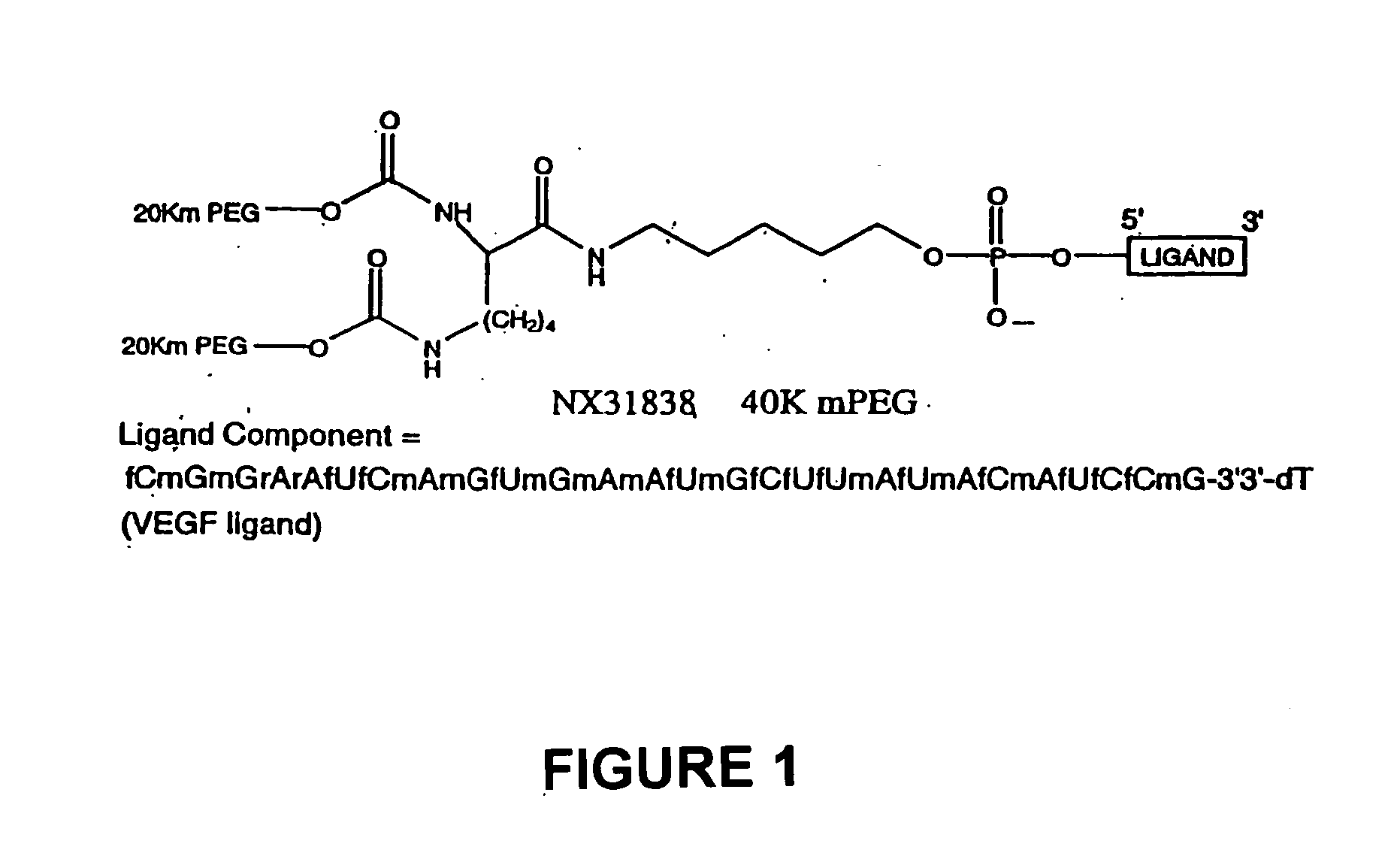Methods for treating ocular neovascular diseases
a technology for ocular neovascularization and treatment methods, which is applied in the direction of genetic material ingredients, drug compositions, and treatment, etc., can solve the problems of high recurrence rate, no standard and effective treatment for exudative adm in most patients, etc., and achieve stable or improved vision, dramatic improvement in vision, and safe and effective treatment
- Summary
- Abstract
- Description
- Claims
- Application Information
AI Technical Summary
Benefits of technology
Problems solved by technology
Method used
Image
Examples
example 1
[0079] Cutaneous Vascular Permeability Assay (Miles Assay)
[0080] One of the biological activities of VEGF is to increase vascular permeability through specific binding to receptors on vascular endothelial cells. The interaction results in relaxation of the tight endothelial junctions with subsequent leakage of vascular fluid. Vascular leakage induced by VEGF can be measured in-vivo by following the leakage of Evans Blue Dye from the vasculature of the guinea pig as a consequence of an intradermal injection of VEGF (Dvorak H F, Brown L F, Detmar M, Dvorak A M. Vascular Permeability Factor / Vascular Endothelial Growth Factor, Microvascular Hyperpermeability, and Angiogenesis. Am J Pathol. 1995, 146:1029.) Similarly, the assay can be used to measure the ability of a compound to block this biological activity of VEGF.
[0081] VEGF165 (20-30 nM) was premixed ex-vivo with EYE001 (30 nM to 1 μM) and subsequently administered by intradermal injection into the shaved skin on the dorsum of gui...
example 2
[0082] Corneal Angiogenesis Assay
[0083] Methacyrate polymer pellets containing VEGF165 (3 pmol) were implanted into the corneal stroma of rats to induce blood vessel growth into the normally avascular cornea. EYE001 was administered intravenously to the rats at doses of 1, 3, and 10 mg / kg either once or twice daily for 5 days. At the end of the treatment period, all of the individual corneas were photomicrographed. The extent to which new blood vessels developed in the corneal tissue, and their inhibition by EYE001, were quantified by standardized morphometric analysis of the photomicrographs.
[0084] The data (not shown) demonstrated that systemic treatment with EYE001 results in significant inhibition (65%) of VEGF-dependent angiogenesis in the cornea when compared to treatment with phosphate buffered saline (PBS). Once daily treatment with 10 mg / kg was as effective as twice daily treatment. The 3 mg / kg dose had activity similar to the 10 mg / kg dose but significant efficacy was no...
example 3
[0085] Retinopathy of Prematurity Study
[0086] Even though ROP is clearly distinct from diabetic retinopathy and AMD, the mouse model of ROP has been used to demonstrate a role for VEGF in the abnormal retinal vascularization that occurs in this disease (Smith L E, Wesolowski E, McLellan A, Kostyk S K, Amato D R, Sullivan R, D'Amore P A. Oxygen-induced retinopathy in the mouse. Invest Ophthalmol Vis Sci. 1994,35:101.) These data provided a rationale for studying the anti-angiogenic properties of EYE001 in this model.
[0087] Litters of 9, 8, 8, 7 and 7 mice, respectively, were left in room air or made hyperoxic and were treated intraperitoneally with PBS or EYE001 (1, 3, or 10 mg / kg / day). The endpoint of the assay, outgrowth of new capillaries through the inner limiting membrane of the retina into the vitreous humor, was assessed by microscopic identification and counting of the neovascular buds in 20 histologic sections of each eye from all of the treated and control mice. A reducti...
PUM
| Property | Measurement | Unit |
|---|---|---|
| concentration | aaaaa | aaaaa |
| wavelengths | aaaaa | aaaaa |
| wavelengths | aaaaa | aaaaa |
Abstract
Description
Claims
Application Information
 Login to View More
Login to View More - R&D
- Intellectual Property
- Life Sciences
- Materials
- Tech Scout
- Unparalleled Data Quality
- Higher Quality Content
- 60% Fewer Hallucinations
Browse by: Latest US Patents, China's latest patents, Technical Efficacy Thesaurus, Application Domain, Technology Topic, Popular Technical Reports.
© 2025 PatSnap. All rights reserved.Legal|Privacy policy|Modern Slavery Act Transparency Statement|Sitemap|About US| Contact US: help@patsnap.com


